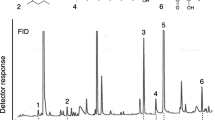Summary
The pygidial (anal) gland was found to be the source of trail pheromone in the antTapinoma simrothi. Bioassays conducted with fractionated pygidial gland secretion indicated that the fraction containing iridodials and iridomyrmecin is responsible for the trail pheromone activity. Thus workers ofT. simrothi may utilize the same glandular exudate for alarm and trail following. At high emission rates from a point source, the ants responded in alarm, e.g., rushed to the source with open mandibles and raised abdomen. When concentrations were low and drawn as a line, the ants followed the secretion calmly. Trails ofT. simrothi are long-lived, having a biological half-life of 10 to 19 days. Quantitative studies of the evaporation rates of the iridodials by gas chromatography resulted in a half-life of 11 days, agreeing with the biological data. The implications of the use of the same glandular secretion for alarm and food recruitments are discussed.
Similar content being viewed by others
References
Attygalle, A. B. and E. D. Morgan, 1985. Ant trail pheromones.Adv. Insect Physiol. 18:1–30.
Billen, J., 1986. Morphology and ultrastructure of the abdominal glands in Dolichoderine ants (Hymenoptera, Formicidae).Ins. Soc. 33:218–295.
Blum, M. S. and H. R. Hermann, 1978. Venoms and venom apparatuses of the Formicidae: Dolichoderinae and Aneuretinae. In:Arthropod Venoms (S. Bettini, Ed), Berlin: Springer-Verlag, pp. 871–894.
Blum, M. S., F. Padovani and E. Amante, 1968. Alkanones and terpenes in the mandibular glands ofAtta species (Hymenoptera: Formicidae).Comp. Biochem. Physiol. 26:291–299.
Bradshaw, J. W. S. and P. E. Howse, 1984. Sociochemicals of Ants. In:Chemical ecology of insects (W. J. Bell and R. T. Cardé, Eds), London, Chapman and Hall, pp. 429–473.
Cammaerts, M. C., 1984. Probable functions for a previously unrecognized pheromone in ants of the genusMyrmica.Behav. Processes 9:135–145.
Cavill, G. W. K., P. L. Robertson and N. W. Davies, 1979. An Argentine ant aggregation factor.Experientia 35:989–990.
Cavill, G. W. K., N. W. Davies and F. S. McDonald, 1980. Characterization of aggregation factors and associated compounds from the Argentine antIridomyrmex humilis.J. Chem. Ecol. 6:371–384.
Couret, H. and L. Passera, 1979. Marquage des pistes alimentaires chez trois espèces de Dolichoderinae (Hym. Formicidae):Tapinoma erraticum (Latr.)Tapinoma nigerrimum (Nyl.) etIridomyrmex humilis (Mayr.).Ann. Sci. Nat. Zool. 1:39–48.
Emery, C., 1925. Révision des espéces paléarctiques du genreTapinoma.Rev. Suisse Zool. 32:45–64.
Fanfani, A. and M. Dazzini Valcurone, 1984. Nuovi Dati Relativi alla “Glandola di Pavan” inIridomyrmex humilis Mayr. (Formicidae Dolichoderinae).Pubbl. Ist. Entom. Univ. Pavia, 28:1–9.
Hefetz, A. and H. A. Lloyd, 1983. Identification of new components from anal glands ofTapinoma simrothi Pheonicium.J. Chem. Ecol. 9:607–613.
Hölldobler, B., 1984. Evolution of insect communication. In:Insect Communication (T. Lewis, Ed), London, Academic Press, pp. 349–378.
Maschwitz, U. and P. Schönegge, 1977. Recruitment gland ofLeptogenys chinensis.Naturwissenschaften 64:589–590.
Miradoli Zatti, M. A. and M. Pavan, 1957. Studi sui Formicidae. III. Nuovi Reperti dell'organo ventrale nei Dolichoderinae.Boll. Soc. Ent. Ital. 87:84–87.
Moser, J. C., R. C. Brownlee and R. Silverstein, 1968. Alarm pheromones of the antAtta texana.J. Insect Physiol. 14:529–535.
Pavan, M., 1955. Studi sui Formicidae. I. Contributo alla conoscenza degli organi gastrali dei Dolichoderinae.Natura (Milano) 46:135–145.
Pavan, M., 1959. Biochemical aspects of insect poisons.Trans. Fourt Int. Congr. Biochem. Vienna, 1958 12:15–36.
Tomalski, M. D., M. S. Blum, T. H. Jones, H. M. Fales, D. F. Howard and L. Passera, 1987. Chemistry and functions of exocrine secretions of the antsTapinoma melanocephalum andT. erraticum.J. Chem. Ecol. 13:253–263.
Van Vorhis Key, S. E. and T. C. Baker, 1982. Trail-following responses of the Argentine ant,Iridomyrmex humilis (Mayr), to a synthetic trail pheromone component and analogs.J. Chem. Ecol. 8:3–14.
Vander Meer, R. K., F. Alvarez and C. S. Lofgren, 1988. Isolation of the trail recruitment pheromone ofSolenopsis invicta.J. Chem. Ecol. 14:825–838.
Wilson, E. O., 1962. Chemical communication among workers of the fire antSolenopsis saevissima (Fr. Smith). 1. The organization of mass foraging. 2. An information analysis of the odour trail. 3. The experimental induction of social responses.Anim. Behav. 10:134–164.
Wilson, E. O. and M. Pavan, 1959. Glandular sources and specificity of some chemical releasers of social behavior in Dolichoderine ants.Psyche 66:70–76.
Author information
Authors and Affiliations
Rights and permissions
About this article
Cite this article
Simon, T., Hefetz, A. Trail-following responses ofTapinoma simrothi (Formicidae: Dolichoderinae) to pygidial gland extracts. Ins. Soc 38, 17–25 (1991). https://doi.org/10.1007/BF01242709
Received:
Accepted:
Issue Date:
DOI: https://doi.org/10.1007/BF01242709




